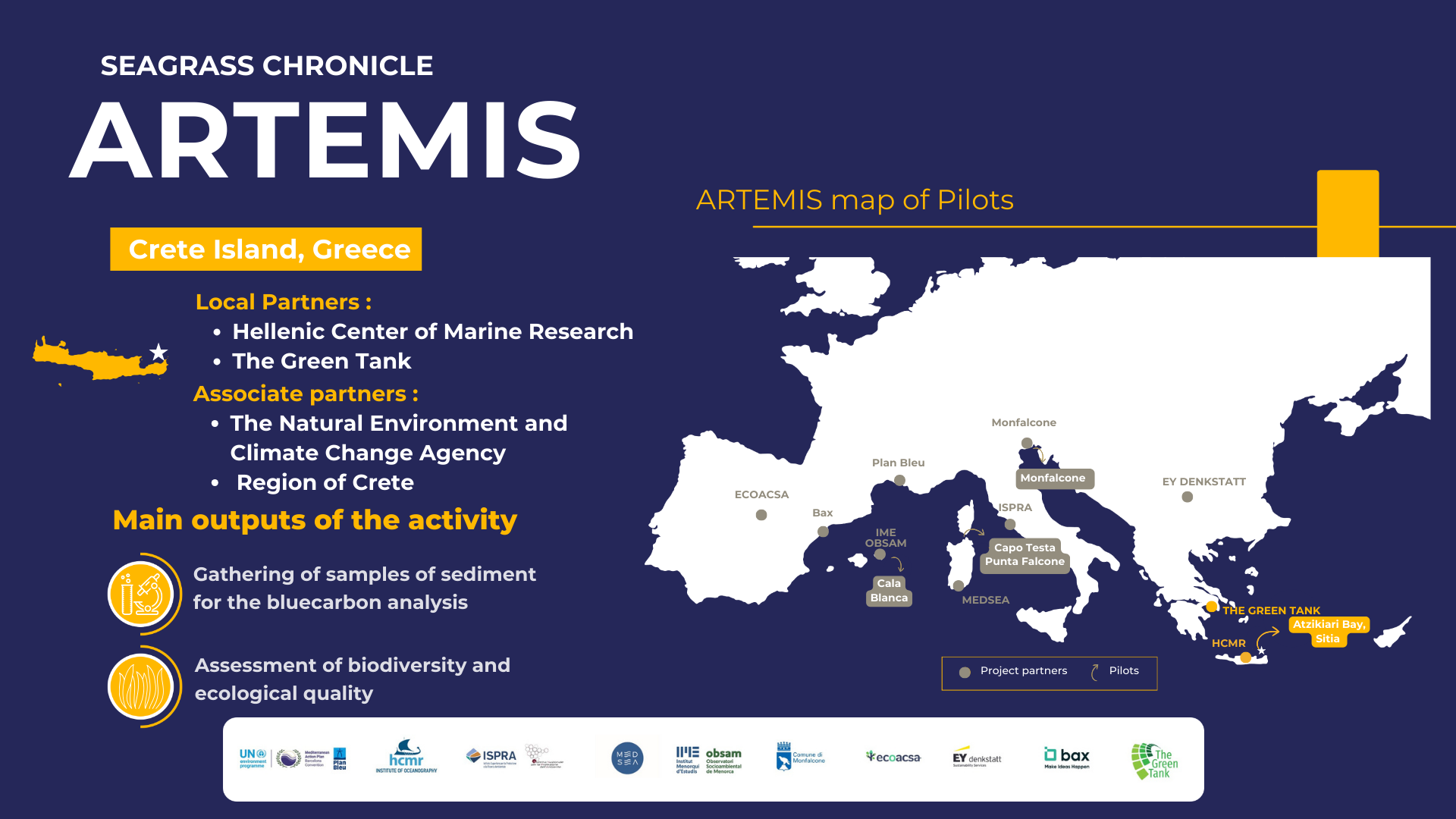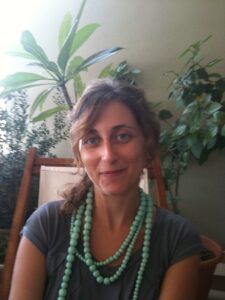
Eugenia Apostolaki | HCMR
The Hellenic Centre for Marine Research (HCMR) has been monitoring Atzikiari Bay since 2019, when the fish farm operating there ceased its activities. Although some natural recovery has been observed in recent assessments, farming has largely destroyed the Posidonia meadows. “We chose this site for the ARTEMIS project because we believe that only when the causes of degradation have been eliminated can natural recovery begin, and restoration can have some success,” says Eugenia Apostolaki, Senior Researcher at HCMR and an expert in seagrass ecology.
The Institute of Oceanography at HCMR has been monitoring the physical, chemical, biological, and geological processes related to the marine environment for 15 years, with a focus on the functioning and evolution of pelagic and benthic ecosystems, as well as the impacts of climate change on marine biota. HCMR has participated in numerous projects, gathering relevant experience in assessing the functioning of seagrass meadows, including their capacity for blue carbon storage and how this is affected by global changes.
Atzikiari Bay is part of the European Natura 2000 network and one of the four pilot sites of the ARTEMIS project (the others being Sardinia and Monfalcone in Italy, and Minorca in Spain). Here, HCMR is assessing the ecological quality status, associated biodiversity, and the blue carbon storage capacity of the meadows.
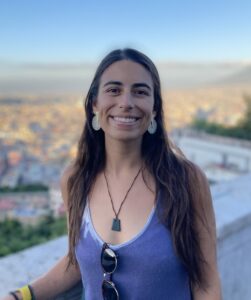
Catalina Garcia | HCMR
“We mapped the area using scuba diving, ROV, and drones,” recalls Catalina Garcia, a PhD student at HCMR and marine biologist. “The bay is very polluted, both because of the fish farm and due to water currents that bring plastic pollution. We conducted a few trials, but the proper transplantation of Posidonia will take place in late spring 2025, after the planned cleanup of the bay in April. In the shallow part of Atzikiari Bay, we mainly found dead matte, only partially repopulated by smaller seagrass species like Cymodocea and Halophila. These species cannot provide the same ecosystem services as Posidonia,” Garcia emphasizes.
The bay is not surrounded by an urban area and has no tourist activity. All the damage has been caused by the fish farm. Climate change further impacts the surviving seagrass meadows. “Throughout the last 20 years, we have studied seagrass production in Greek waters, and we have recorded a decline. There is a direct connection between rising temperatures and the degradation of Posidonia” says Garcia.
The role of the meadows in protecting and enhancing marine biodiversity is fundamental, as demonstrated by HCMR’s analyses in Atzikiari. During surveys conducted in September, the team recorded 24 fish species and 23 benthic invertebrate species, along with their abundance and size. Additionally, sediment and dead matte samples were collected, along with Posidonia shoots, to document smaller biodiversity components that occupy the surface of the leaves and the underlying matte. Notable observations included juvenile stingrays (Dasyatis pastinaca), the long-snouted seahorse (Hippocampus guttulatus), and the loggerhead sea turtle (Caretta caretta) at the reference site.
“The impacted sites showed an impoverished state in terms of biodiversity, with significantly fewer taxa overall and differences in species composition” explains Thanos Dailianis, Principal Researcher at the Institute of Marine Biology, Biotechnology & Aquaculture at HCMR. Another notable issue, the survey reveals, is the presence of introduced species, a common concern along the Eastern Mediterranean coastline. This includes a widespread abundance of the pufferfish (Torquigener flavimaculosus) and the Indo-Pacific seagrass (Halophila stipulacea). “Analysis of the results from the biodiversity assessment of the Cretan pilot site will be completed in the first quarter of 2025, and the results are expected to guide future implementation strategies over the course of the ARTEMIS project” concludes Dailianis.
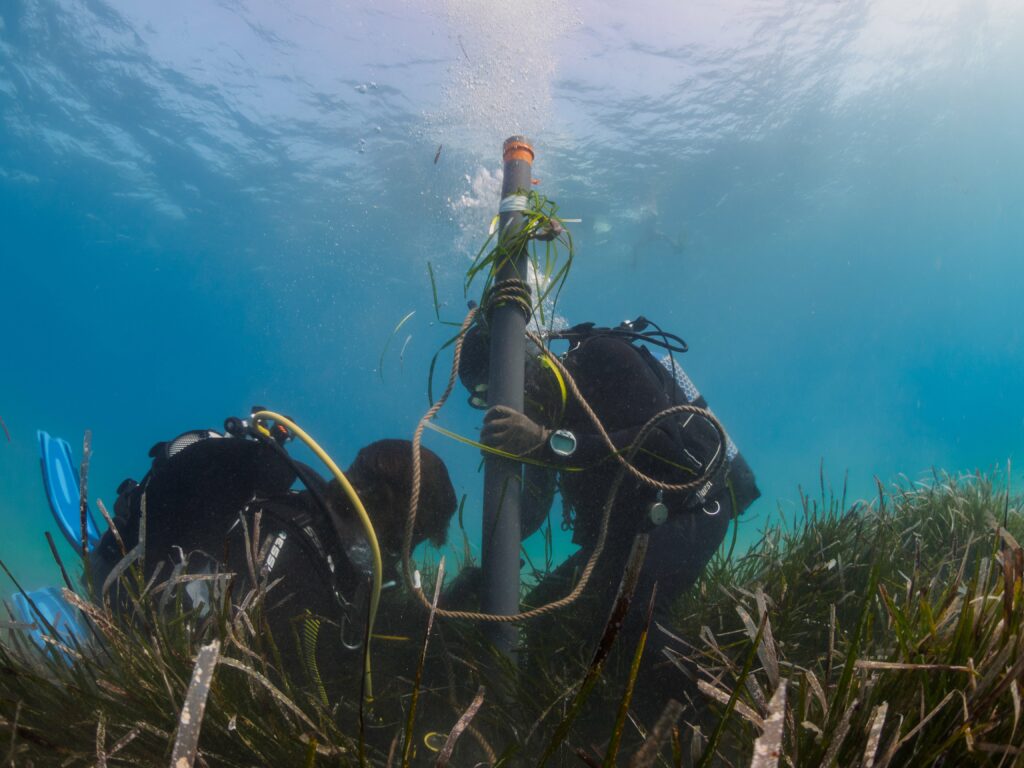
ARTEMIS | Exploring the Depths of Posidonia oceanica in Atzikiari Bay | ©️ Thanos Dailianis
“Several Posidonia meadows across the Mediterranean basin have been degraded. Their role in protecting marine biodiversity and helping us adapt to climate change is crucial. Therefore, we fully support the targets set by the ARTEMIS project. As scientists, we can provide the roadmap for conservation and restoration. However, this process must be accompanied by significant political decisions to safeguard these critical ecosystems” remarks Eugenia Apostolaki.
In line with this, The Green Tank, the other key institution involved in the ARTEMIS project in Greece, is exploring the national policy and financial framework to advance ARTEMIS objectives. Mapping and engaging with key stakeholders is one of The Green Tank’s main ongoing activities. The independent, non-profit
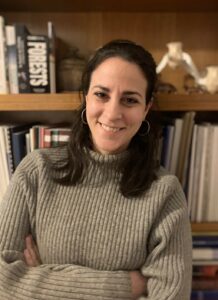
Dimitra Syrou | The Green Tank
think tank has been working at local, regional, and national levels over recent months to both inform stakeholders and learn from them as the steps for a long-term restoration plan for Posidonia oceanica are outlined. “We work across various levels, interviewing experts and officials about the legal and institutional framework in which the future plan will be embedded. If we identify a gap or an opportunity in the existing framework, we can then shape specific policy recommendations. Our aim is to draw from the specific effort in Atzikiari to produce a sustainable governance framework that can be applied on a national scale. To achieve this, we must listen to all voices and understand all viewpoints,” explains Dimitra Syrou, Nature Policy Associate at The Green Tank, with an academic research background in protected area governance.
The Green Tank plans to conduct around ten stakeholder interviews before the end of 2024, with more to follow in early 2025. These interviews will include representatives from local, regional, and central government, as well as residents, local businessmen, fishermen, landowners, hotel owners, and diving clubs. “So far, all stakeholders appear eager to collaborate. They are very interested in the concept of ecosystem services, Posidonia’s capacity to absorb carbon emissions, and its role in reducing the impact of extreme phenomena such as floods, sea storms, and coastal erosion. During the interviews, while highlighting the benefits of nature, we also explore options for covering restoration costs. The concept of ‘Payment for Ecosystem Services’ and similar financial schemes is quite innovative for Greece. Our role is to acknowledge perceptions and reactions and help formulate sound, feasible recommendations for such schemes, adjusted to the country’s realities. We do not want to design proposals that are empty and impractical” states Dimitra Syrou.
In late spring 2025, two stakeholder workshops—one in Heraklion and one near Atzikiari—will bring stakeholders together for discussions. These workshops will be crucial moments to enrich the fieldwork undertaken by HCMR. Following this, the ARTEMIS partners will have the necessary components to design a comprehensive, scientifically robust restoration plan for Atzikiari Bay that benefits from stakeholder input and aligns with Greece’s policy and financial framework.
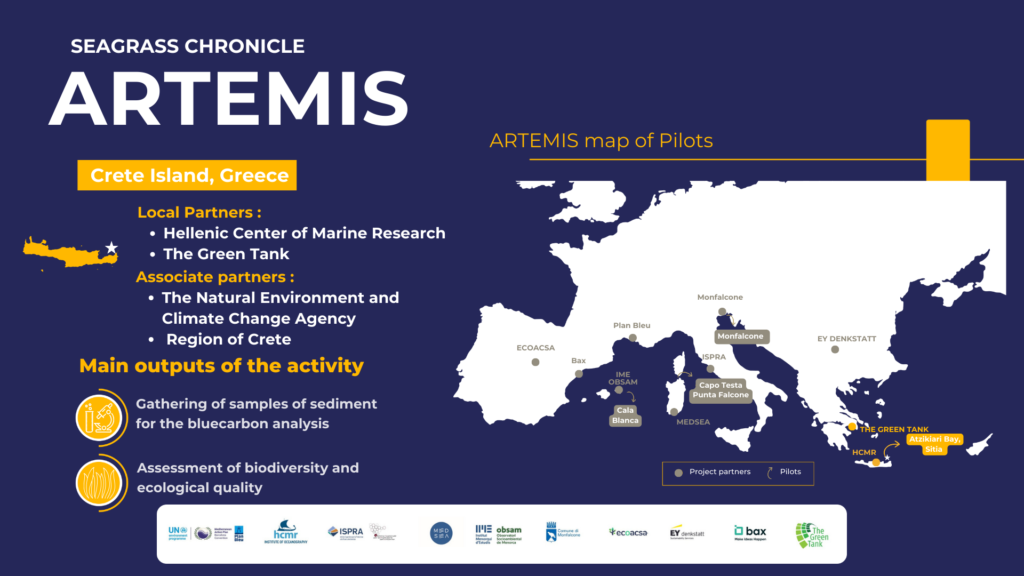
ARTEMIS – Map of pilot sites | Focus on Crete site

